The function of dividing remainder and dividing by integer (MOD and QUOTIENT) in Excel
Calculating data in Excel spreadsheets, you will not be able to ignore division functions. Divider functions are common and often used when division operations are needed.
There are two different division functions:
- MOD function: divide the remainder.
- QUOTIENT function: divide by integer.
The following article describes the syntax and usage of two division functions: MOD and QUOTIENT.
MOD function
Description
The MOD function is a division function that returns the remainder of the division.
Syntax
MOD (number, divisor)
Inside:
- number: the number you want to find the balance (the number to be divided), required.
- divisor: divisor , required.
Note
- Results with the sign of the divisor, regardless of the sign of the dividend.
- If the divisor is 0, then the MOD function returns the error value.
For example
Given the following data sheet:
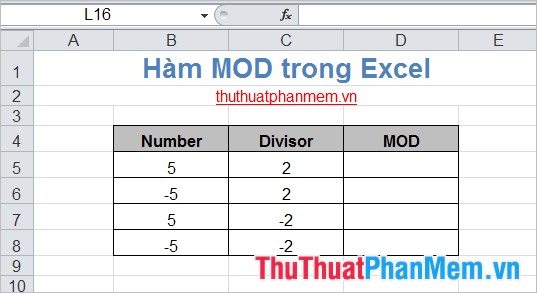
Requirements: Calculate the balance when taking the number in Number divided by the Divisor.
Applying the MOD function formula to the first cell: = MOD (B5, C5) we get the following:

You do with the next row and follow the results of the MOD function always the same sign with the divisor.
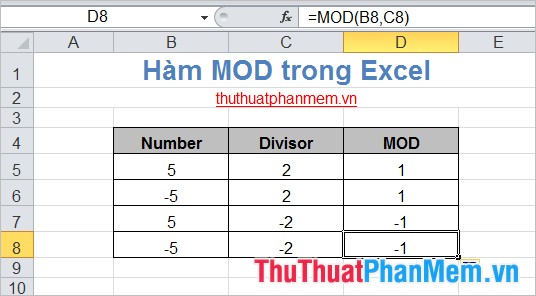
QUOTIENT function
Description
The QUOTIENT function is a division function that returns the integral of a division.
Syntax
QUOTIENT (numerator, denominator)
Inside:
- Numerator: is a divisible and required number.
- denominator: a divisor, required.
If either numerator or denominator is not a number, QUOTIENT returns the error value.
For example
Give the data table as follows:
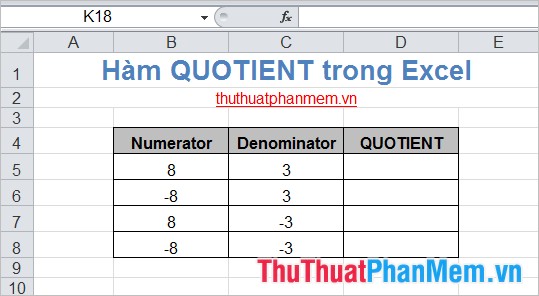
Requirement: Use the QUOTIENT function to get the integer part when taking Numerator numbers and dividing by Denominator numbers.
Apply the QUOTIENT function formula to cell D5: = QUOTIENT (B5, C5) .
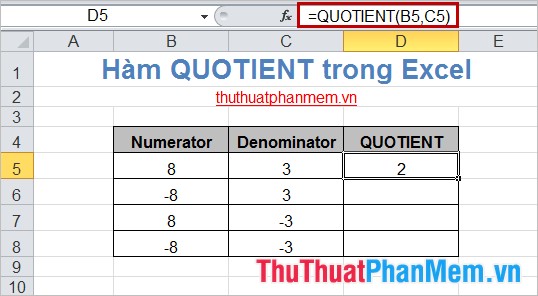
Similar to other data, you will get the following results:
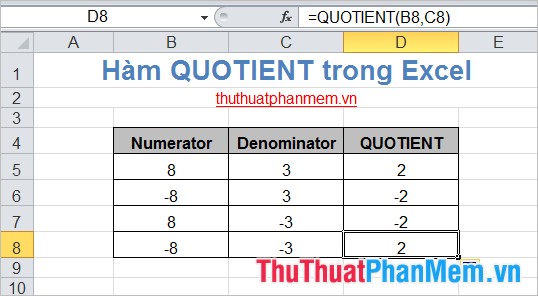
This article has introduced to you the syntax and usage of two division functions: MOD and QUOTIENT. For each different requirements you can apply balance division or whole number division accordingly. Good luck!
You should read it
- Tips for handling columns in Microsoft Word
- How to split columns in Word - Instructions on dividing columns in Word 2007, 2010, 2013, 2016
- The INT (Function rounds a number down to the nearest integer of a number) in Excel
- Dividing hard drive right in Windows 10 does not lose data
- Basic Excel functions that anyone must know
- How to use Hlookup function on Excel
- How to use the SUM function to calculate totals in Excel
- The strncpy () function in C
May be interested
- MONTH function - The function converts a serial number into a month in Excel
 month function: function performs month value separation in a specific date time month. the return month value is an integer between 1 and 12.
month function: function performs month value separation in a specific date time month. the return month value is an integer between 1 and 12. - 6 Conditional Functions That Make Excel Spreadsheets Smarter
 if your formulas get complex, conditional functions are a smarter choice, hidden in plain sight.
if your formulas get complex, conditional functions are a smarter choice, hidden in plain sight. - The DAY function - The function returns the day of the day, month and year in Excel
 the day function: the function takes a date value from a date value. the return value is an integer between 1 and 31.
the day function: the function takes a date value from a date value. the return value is an integer between 1 and 31. - How to use COUNTIF function on Excel
 the countif function on excel is the cell count function to satisfy the given condition, often used in statistics tables.
the countif function on excel is the cell count function to satisfy the given condition, often used in statistics tables. - 8 little-known Excel functions that can save you a lot of work
 even seasoned excel users often find themselves stuck performing tasks manually that could be automated with a few clever functions.
even seasoned excel users often find themselves stuck performing tasks manually that could be automated with a few clever functions. - How to use MID functions to get strings in Excel
 mid function in excel is a function that takes the middle character string corresponding to the value that the user requires to perform.
mid function in excel is a function that takes the middle character string corresponding to the value that the user requires to perform. - DAY function in SQL Server
 the day function in sql server returns an integer that is the day of the month (from 1 to 31) from the time passed.
the day function in sql server returns an integer that is the day of the month (from 1 to 31) from the time passed. - How to use Excel's VALUE function
 excel's value function will convert a string to a digital form, which can be combined with other functions such as left function, right function, mid function.
excel's value function will convert a string to a digital form, which can be combined with other functions such as left function, right function, mid function. - How to use the WRAPROWS function in Excel
 having trouble with handling large data sets in excel? then learn how to use the wraprows function to split them into more manageable rows.
having trouble with handling large data sets in excel? then learn how to use the wraprows function to split them into more manageable rows. - How to use the IFS function in Excel 2016
 the ifs function in excel is a logical function introduced in excel 2016. this function is a function that replaces the nested if function and is much easier to use. the ifs function checks one or more conditions and returns a value that meets the first true condition.
the ifs function in excel is a logical function introduced in excel 2016. this function is a function that replaces the nested if function and is much easier to use. the ifs function checks one or more conditions and returns a value that meets the first true condition.










 Power function (exponential) in Excel
Power function (exponential) in Excel The Text function converts a numeric value into text in Excel
The Text function converts a numeric value into text in Excel Average function (calculate the average) in Excel
Average function (calculate the average) in Excel Find, FindB functions in Excel - The function finds a text string in another document in Excel
Find, FindB functions in Excel - The function finds a text string in another document in Excel The INT (Function rounds a number down to the nearest integer of a number) in Excel
The INT (Function rounds a number down to the nearest integer of a number) in Excel The Match function (the function searches for a specified value in an array or cell range) in Excel
The Match function (the function searches for a specified value in an array or cell range) in Excel